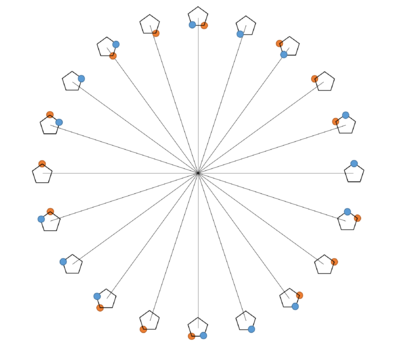Sugar ring pucker
From Proteopedia
Sugar ring pucker refers to conformations of rings, particularly 5-membered rings.
Envelope and twist conformations in 5-membered ringsFor a 5-membered ring with perfectly tetrahedral geometry of each atom in the ring, there is minimal strain if the ring were planar (~353 degree rotation around the ring instead of 360). However, all hydrogens/substituents would be ecplised, which is not the lowest energy conformation.[1] To relieve the strain, one or two atoms move out of the plane. The conformation with one atom out of the plane is called (endo or exo depending on whether the atom is above or below the plane). You can show the 5 possible planes defined by three consecutive ring atoms by clicking on the radio buttons below. In three cases, the remaining two atoms are on the same side of the plane. In two cases ("123" and "512"), carbon 4 is moved out of the plane, making this conformation a carbon-4 envelope.
The conformation with two consecutive atoms out of the plane, one above and one below, is called . In the example, carbon 4 and 5 are out of plane. Again, you can define a plane using the five possible sets of three consecutive atoms (buttons above). As you will discover, the 4/5 twist is very close in conformation to the carbon 4 envelope (choose the 512 plane) and the carbon 5 envelope (choose the 234 plane). More than two atoms are never out of plane because the remaining three atoms always define a plane. Describing conformations with a pseudorotation angleTo classify conformations unambiguously, the pseudorotation angle and amplitude are used. The image above shows conformations of cyclopentane ordered by pseudorotation angle. The pentagons represent the five-membered ring, with atoms above the plane shown as blue circles, those below the plane shown as orange circles, and the three or four others in the plane. Conformations close in pseudorotation angle are also close in root mean square distances of corresponding atoms. There are two definitions in the literature that lead to very similar results.[2] Once the pseudoration angle is calculated, you can name the conformation and plot it in a pseudorotation diagram (see e.g. [3]). This dance performance shows how the conformations change as the pseudorotation angle changes. Conformations of ribose ringsThe two most common conformations are C3' endo and C2' endo. For ribose, endo refers to the side of the glycosidic bond (i.e. the direction of the nucleobase in nucleosides). It is also the direction of the 5'-OH group, whereas the 2'-OH and the 3'-OH are on the exo side. The animation shows a morph between a conformation. Use the buttons to toggle groups attached to the robise ring. Note how the distance between the 5'-OH and 3'-OH groups (or that of the attached phosphates, if displayed) changes when the conformation changes.
Here is the same animation, but in the same location and orientation throughout the morph. Use the buttons above to interactively change the view and start and stop the animation.
B-DNA vs A-DNAB-DNA is the most common conformation of double-stranded DNA. B-DNA can change conformation to A-DNA in non-native high salt solutions. Douple-stranded RNA has a conformation similar to that of A-DNA. When DNA changes from the , the sugar pucker changes, the distance between adjacent phosphate groups decreases, and the stacking of the nucleobases change. Try figuring out which conformation is A and which is B before you click on the buttons below.
| ||||||||||||

